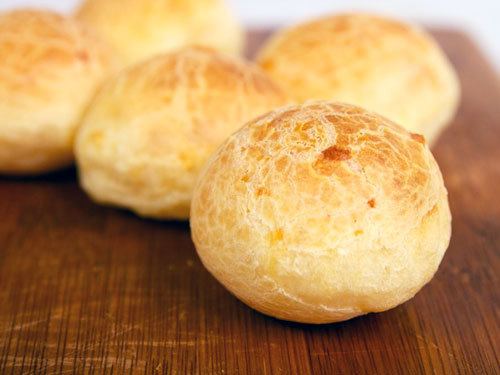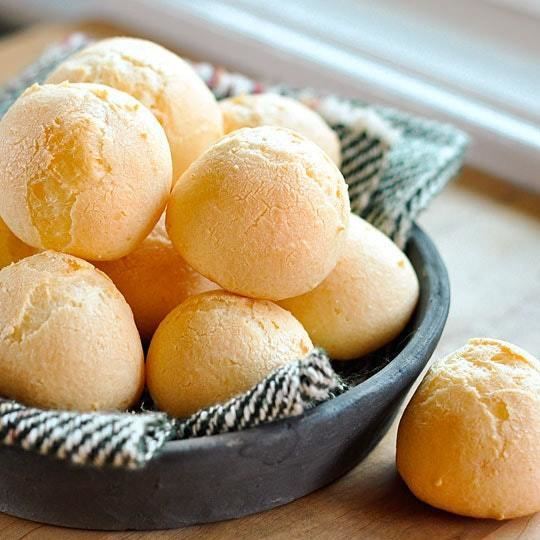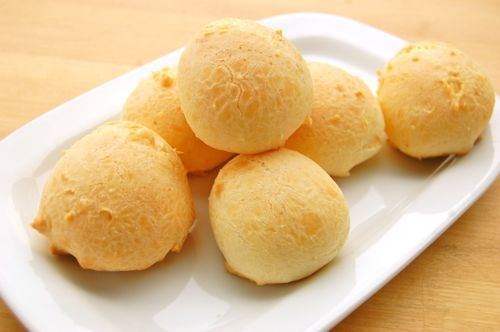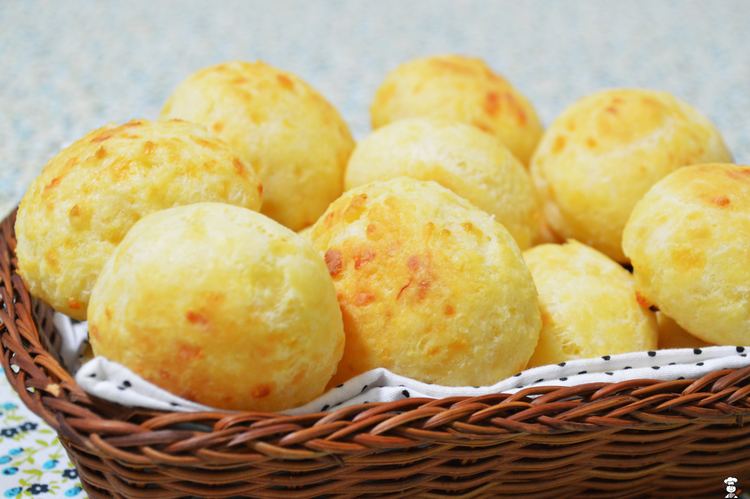 | ||
Similar Requeijão, Coxinha, Tapioca, Minas cheese, Pastel | ||
P o de queijo brazilian cheese bread food busker
Pão de queijo ([ˈpɐ̃w dʒi 'kejʒʊ], "Cheese Bread" in Portuguese) or Brazilian cheese bread is a small, baked cheese roll, a popular snack and breakfast food in Brazil. It is a traditional Brazilian recipe, from the state of Minas Gerais. Though its origins are uncertain, it is speculated that the recipe has existed since the eighteenth century, although it became popular around the 1950s.
Contents
- P o de queijo brazilian cheese bread food busker
- Cheesy p o de queijo
- History
- Main ingredients
- Preparation
- Brazil
- United States
- Japan East Asia
- References

Pão de queijo originated from African slaves like many other Brazilian foods. Slaves would soak and peel the cassava root and make bread rolls from it. At this time, there was no cheese in the rolls. At the end of the 19th century, more ingredients became available to the Afro-Brazilian community such as milk and cheese. They added milk and cheese to the tapioca roll making what we now know as Pão de queijo. It is also widely eaten in northern Argentina and is inexpensive and often sold from streetside stands by vendors carrying a heat-preserving container. In Brazil, it is also very commonly found in groceries, supermarkets and bakeries, industrialized or freshly made.

Despite being referred to as "bread", the Cheese Bread is basically a type of starch tart cookie or sweet plus eggs, salt vegetable oil and cheese, with soft and elastic consistency and with a few variations.

Cheesy p o de queijo
History

With the discovery of mines near Ouro Preto around 1700, 1/5 of the Brazilian population, mainly slaves, occupied a vast territory, moving from the Northeast and shifting the economic hub of the colony towards the Southeast.

The mining cycle caused a huge impact and stimulus to the production of staple foods and this is when cheese bread was created. The Northeast and the nearest regions obtained beans, rice, corn and its cornmeal, pork and lard, milk and cheese. More distant areas such as the gaucho pampa, began to offer kind of beef meat. It is said that the cheese bread was offered by slave women to the farmers. By that time, it was hardly found the wheat flour, raw material of classical baking. Typical of temperate regions, the ancient cereal never combined with the warmth of the Brazilian Northeast, and was then imported from Europe to here to serve the king's noblemen.
Creatively, mining cooks replaced by non-existent wheat starch, derived from cassava tuber with tupiniquins origins. Added the mass cured cheese chips, hardened and grated, and taken to the oven, turned out to like being called "bread".
Main ingredients
There are several different recipes where the ingredients and the type of cheese vary widely - as well as the final result. Some of them use sweet starch, other sour, or even both. But what gives it its main feature is that it is based on starch cassava and some kind of cheese.
The fat - lard, vegetable oil, butter or margarine - acts as a molecular lubrificant, contributing to the elastic texture of the dough.
The egg gives colour and flavour to the recipe.
The type of cheese varies according to preference or availability. The most used are mozzarella, parmesan, and the more traditional ripened cheese and standard cheese, both also from Minas Gerais. The cheese gives the typical flavor of the cheese bread, hence its name.
There is also the boiled cheese bread with a preparation technique that requires boiling water while preparing, sometimes mixed with vegetable oil in flour. The boiled cheese bread has the closest taste of natural, as in the boiling process the dough is pre-cooked.
Some recipes use potato.
Preparation
Pães de queijo are formed into small balls, around 3-5 centimeters in diameter (though they may be larger) and about 50 calories in each roll. The cassava flour is a powerful starch which is key to the texture of the pão de queijo; unlike other types of bread, pão de queijo is not leavened. Small pockets of air within the dough expand during baking and are contained by the elasticity of the starch paste. The tapioca starch used in pão de queijo makes this snack gluten free. Varieties of stuffed pães de queijo with catupiry, hot and melted goiabada, doce de leite and other variations can be found in Brazil.
Brazil
In Brazil, pão de queijo is a popular breakfast dish and snack. It continues to be widely sold at snack bars and bakeries and it can also be bought frozen to bake at home. In Brazil, cheese puff mix packages are easily found in most supermarkets.
United States
Given its growing popularity in the US, the frozen packages of pao de queijo can now be found in some American grocery stores such as Costco, County Market, HEB, World Market and Whole Foods.
Japan / East Asia
Pão de queijo arrived in Japan with the dekasegi. It is usually made with rice flour instead of the cassava (tapioca) starch.
